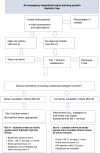Not too sick, not too well: reducing the diagnostic void in pediatric emergency medicine
- PMID: 39349821
- PMCID: PMC11624129
- DOI: 10.1038/s41390-024-03598-2
Not too sick, not too well: reducing the diagnostic void in pediatric emergency medicine
Abstract
Emergency clinicians must rapidly evaluate the acutely ill or injured child. In a resource-stressed environment, "spotting the sick child" is essential for appropriate stabilization, treatment, and further management. Overlooking clinical features in a child's presentation may impede timely care. Complicating factors include the volume of patients seeking care, unfettered access to emergency services, parental perceptions and expectations, and clinician biases. Notwithstanding, after an appropriate history and physical exam, some children do not fall under the standard rubric of "sick or not sick". This article explores strategies to recognise the child who may lie in the diagnostic void between those who are obviously well and those who are not.
© 2024. The Author(s).
Conflict of interest statement
Competing interests: DR is social media editor of Pediatric Research. The other authors declare no competing interests.
Figures
References
-
- McDermott, K. W., Stocks, C. & Freeman, W. J. Overview of Pediatric Emergency Department Visits, 2015. HCUP Statistical Brief #242. August 2018. Agency for Healthcare Research and Quality, Rockville, MD. www.hcup-us.ahrq.gov/reports/statbriefs/sb242-Pediatric-ED-Visits-2015.pdf (2018).
-
- Cairns, C., Kang, K. & Santo, L. National Hospital Ambulatory Medical Care Survey: 2018 emergency department summary tables. Available from: https://www.cdc.gov/nchs/data/nhamcs/web_tables/2018_ed_web_tables-508.pdf (2018).
-
- Santo, L. & Okeyode, T. National Ambulatory Medical Care Survey: 2018 National Summary Tables. Available from: https://www.cdc.gov/nchs/data/ahcd/namcs_summary/2018-namcs-web-tables-5... (2018).
-
- Butun, A., Linden, M., Lynn, F. & McGaughey, J. Exploring parents’ reasons for attending the emergency department for children with minor illnesses: a mixed methods systematic review. Emerg. Med. J.36, 39–46 (2019). - PubMed


